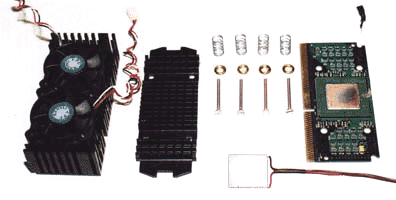
 |
Tellurex's
Introduction to Thermoelectrics
Tellurex's
Thermoelectric FAQ
Melcor's
Thermoelectric Engineering Handbook
My first idea about using a TEC was to simply attach it in between the CPU and my oversized dual-fan heat sink, power it up and all would be fine. Though I have seen many peltier CPU coolers for sale that were designed this way, my reading told me that this was not the most effective use of the device. However, if I was going to learn how to make a TEC CPU cooler that worked, I had to start somewhere.
Attempt 1
Starting with my Vantech CPU Cooler heat
sink, I added the peltier element, Part
# 580-0052 from Meci
Surplus and centered it between the heat sink and chip. Both
sides of the TEC were coated with a very thin layer of thermal compound.
The peltier sandwich was held together nuts and bolts with springs added
to even the clamping pressure.

.

|
|
|
Start |
Start |
End |
End |
|
|
|
|
|
|
|
|
Intro . |
voltage limits |
high volts |
trying peltiers |
second attempt |
stable @ 504 |
lower voltage |
case heat |
final thoughts |
build it |